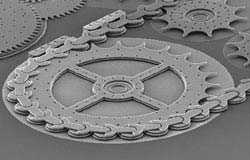Scientists Fabricate Microscale ’Bicycle Chain’

Image: Courtesy of Barry Ritchey/Sandia National Laboratories
Scientists have manufactured a microscale bicycle chain comprised of silicon links thinner than a human hair that behaves just like its regular-sized counterpart. The tiny chain system could one day help power microscopic devices.
Ed Vernon, a technologist at Sandia National Laboratories, designed and patented the 50-link silicon microchain (see image), which was built by the lab’s Microelectronics Development Laboratory (MDL). The centers of the tiny links are separated by just 50 microns. The links can rotate 52 degrees in either direction with respect to their counterparts in the chain without breaking the support structure. Such flexibility, the scientists note, means multiple gears powered by the chain need not lie in a straight line.
Such a gear and chain mechanism could conceivably replace the multiple drivers currently required to run microelectromechanical systems (MEMS) motors. “All those drives take up a lot of real estate on chips,” Vernon notes. A single chain, however, could rotate many drive shafts or drive a MEMS device from a motor situated at a distance. But MEMS researcher Kaigham Gabriel of Carnegie Mellon University observes that “there are very few applications in the commercial space that require continuous rotary motion or the translation thereof.” He also cautions that microscopic gears tend to lock together less tightly than do macroscopic ones. One thing is for certain, any applications that do come of the new work are a long way off. Says Vernon: “I expect it will be three to four years before you’ll see anything this complex out in industry.”
Media Contact
All latest news from the category: Materials Sciences
Materials management deals with the research, development, manufacturing and processing of raw and industrial materials. Key aspects here are biological and medical issues, which play an increasingly important role in this field.
innovations-report offers in-depth articles related to the development and application of materials and the structure and properties of new materials.
Newest articles

First-of-its-kind study uses remote sensing to monitor plastic debris in rivers and lakes
Remote sensing creates a cost-effective solution to monitoring plastic pollution. A first-of-its-kind study from researchers at the University of Minnesota Twin Cities shows how remote sensing can help monitor and…

Laser-based artificial neuron mimics nerve cell functions at lightning speed
With a processing speed a billion times faster than nature, chip-based laser neuron could help advance AI tasks such as pattern recognition and sequence prediction. Researchers have developed a laser-based…

Optimising the processing of plastic waste
Just one look in the yellow bin reveals a colourful jumble of different types of plastic. However, the purer and more uniform plastic waste is, the easier it is to…



